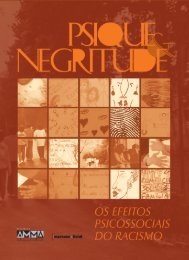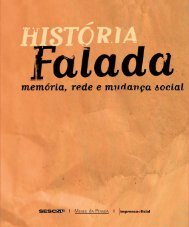CLÁSSICOS BRASILEIROS BRAZILIAN CLASSICS - Imprensa Oficial
CLÁSSICOS BRASILEIROS BRAZILIAN CLASSICS - Imprensa Oficial
CLÁSSICOS BRASILEIROS BRAZILIAN CLASSICS - Imprensa Oficial
Create successful ePaper yourself
Turn your PDF publications into a flip-book with our unique Google optimized e-Paper software.
Brazilian Classics<br />
A selection of authors with works in public domain<br />
16<br />
AFONSO ARINOS<br />
(1868 – 1916)<br />
Afonso Arinos de Melo Franco, after finishing<br />
his Law studies in São Paulo, settled himself in<br />
Ouro Preto. An old colonial city in his home state<br />
of Minas Gerais, there he became a Brazilian<br />
History professor. He went on to found two of his<br />
homeland’s most important institutions: Minas’<br />
Law School and its Public Archive. During the<br />
1890’s, Afonso Arinos collaborated with many<br />
periodicals such as Revista Brasileira and Revista<br />
do Brasil. He also ran the influential Jornal do<br />
Comércio in São Paulo during the infamous<br />
Canudos Campaign, when he defended the<br />
restoration of the recently dethroned Brazilian<br />
imperial family. His newspaper short stories,<br />
based on his knowledge of Minas Gerais’ remote<br />
and isolated regions and peoples, led to the<br />
publication of the book Pelo Sertão (Through the<br />
backlands) (1898). Afonso Arinos is considered<br />
one of the leading figures under the regionalist<br />
literary banner. In 1903 he was received as a<br />
member of the Brazilian Academy of Letters.<br />
Review<br />
Main works<br />
Excerpt<br />
The haunting<br />
On the margin of the drover’s path, on a big<br />
prairie, where ema-cinnamon and Santowood<br />
grew aplenty, there was a shack. The old haunted<br />
house, with its big rocky stairway leading to the<br />
porch, didn’t seem forsaken. The wanderer would<br />
see it from a distance, with a chapel beside it and<br />
a carved stone cross, blackened, arms wide open,<br />
in constricted prayer to the skies. In that clearing<br />
where the dark green woods didn’t enjoy much<br />
sun, the blurry color of the house would soften<br />
even more the lackluster green of the fields.<br />
And those who were not droving through those<br />
lands would, without a doubt, halt before the<br />
wide open gate, longing to know the reason<br />
why those farm people were so evasive; evasive<br />
to a point of not even showing up behind the<br />
windows when large herds, scathing in front of<br />
the land lots, would trail away.<br />
Facing the roadway, the large tiled ranch, with its<br />
big bracings of rose pepper shrubs and its fences<br />
full of iron rings, would open up, still far from<br />
the main manor, inviting the passerby to shelter<br />
himself. On the ground one could see a stone<br />
trivet with signs of old burned out fires and, here<br />
and there, on the beddy and smooth terrain, lazy<br />
animals wallowed.<br />
The regionalist writer<br />
"In search of the Brazilian theme, alongside the Indianist cycles, the backcountrism, the caboclo theme, the cangaceiro<br />
banditism, the drylands and the gold hunting topics, Afonso Arinos introduced to Brazilian fiction the Central Plateau’s<br />
inhospitable and wild environment. His realist technique was characterized by a search for accurateness and verisimilitude,<br />
without any tendency to stylize and fantasize. Men, mores, the backland landscape are snapshot with a lot of confidence<br />
and in a style of his own, with special mention to the reproduction of typical colloquial speech."<br />
(Afrânio Coutinho e J. Galante de Sousa, Enciclopédia de literatura brasileira)<br />
The nationalist trace<br />
“In everything written by Afonso Arinos, a deep trace of his healthy and conscious nationalism is present. He would affirm:<br />
‘I am the bell who goes to the top of the tower to call you to the Homeland cult’.”<br />
(Paulo Dantas, Os sertões de Euclides e outros sertões)<br />
Os jagunços (1898); Pelo sertão (1898); Notas do dia (1900); A unidade da pátria (1917); O contratador de diamantes<br />
(1917); Lendas e tradições brasileiras (1917); O mestre de campo (1918); Histórias e paisagens (1921).









